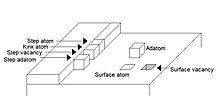Adatom

An adatom is an atom that lies on a crystal surface, and can be thought of as the opposite of a surface vacancy. This term is used in surface chemistry and epitaxy, when describing single atoms lying on surfaces and surface roughness. The word is a portmanteau of "adsorbed atom". A single atom, a cluster of atoms, or a molecule or cluster of molecules may all be referred to by the general term "adparticle". This is often a thermodynamically unfavorable state. However, cases such as graphene may provide counter-examples.[1]
Applications
In 2012, scientists at the University of New South Wales were able to use phosphine to precisely, deterministically eject a single silicon atom onto a surface of epitaxial silicon. This resulting adatom created what is described as a single-atom transistor. Thus, inasmuch as chemical empirical formulas pinpoint the locations of branching ions that are attached to a particular molecule, the dopant of silicon based transistors and other such electronic components will have the location identified of each dopant atom or molecule, along with the associated characteristic of the device based on the named locations. Thus, the mapping of the dopant substances will give exact characteristics of any given semiconductor device, once all is known.[2]
References
- ^ Marian A. Herman; Wolfgang Richter; Helmut Sitter (2004). Epitaxy: Physical Principles and Technical Implementation. Springer. p. 322. ISBN 3-540-67821-2.
- ^ Fuechsle, Martin; Miwa, Jill A.; Mahapatra, Suddhasatta; Ryu, Hoon; et al. (February 19, 2012). "A single-atom transistor". Nature. Retrieved February 20, 2012.
